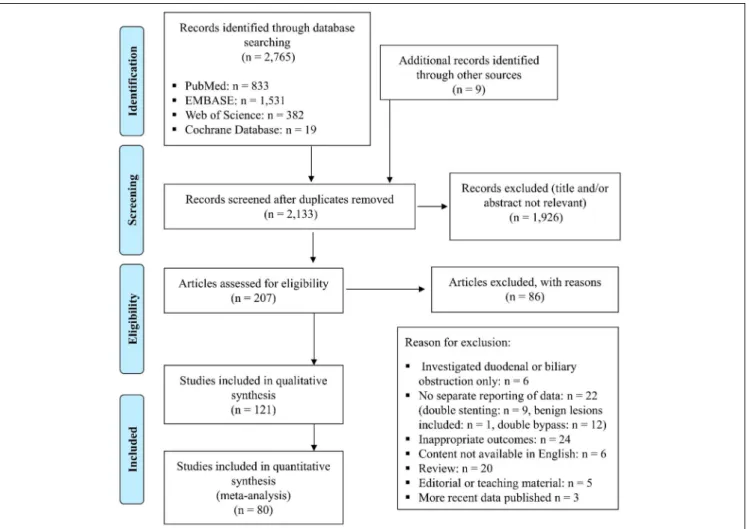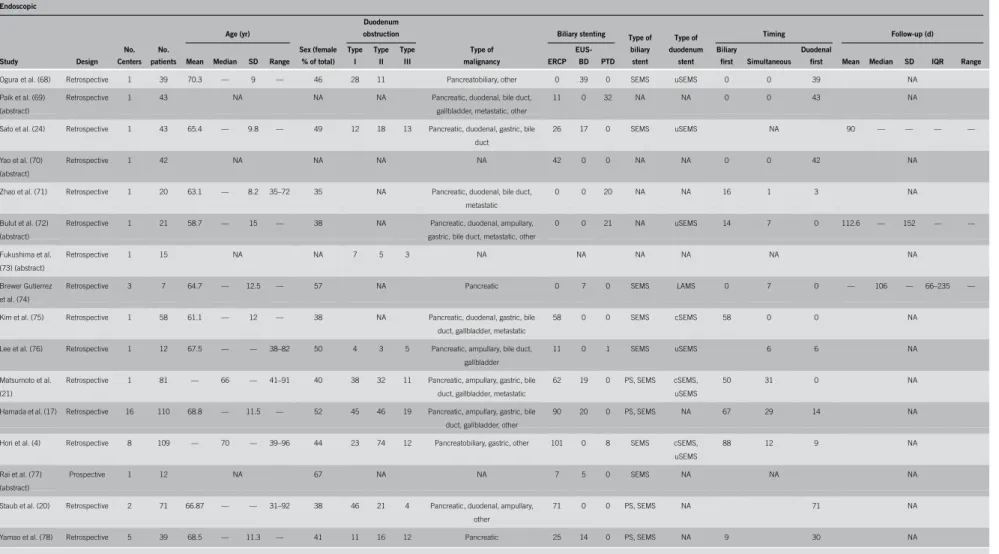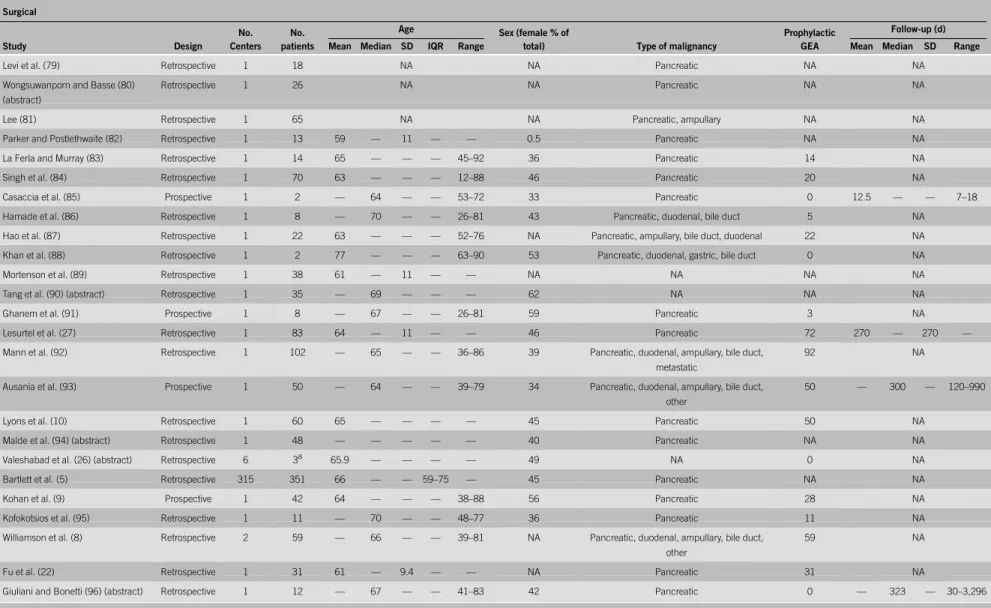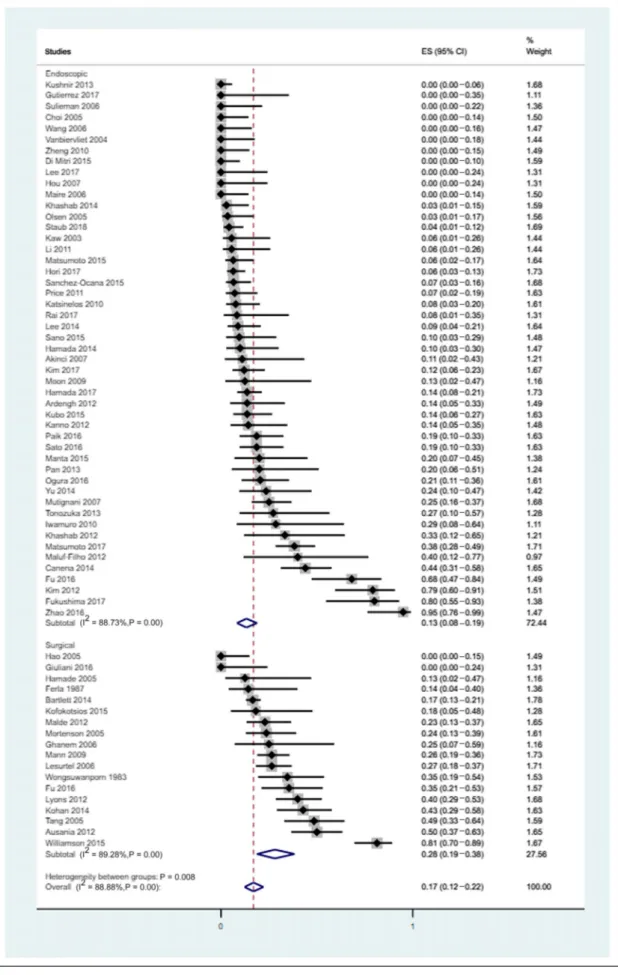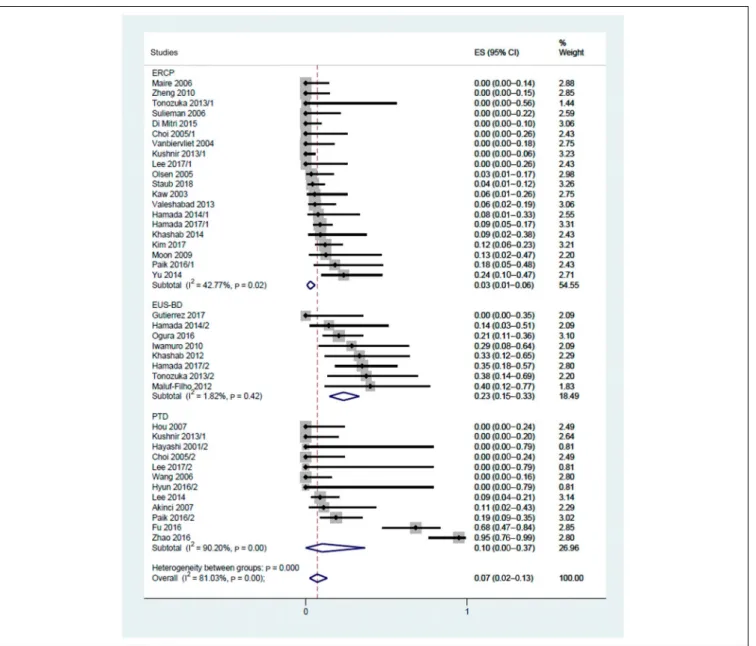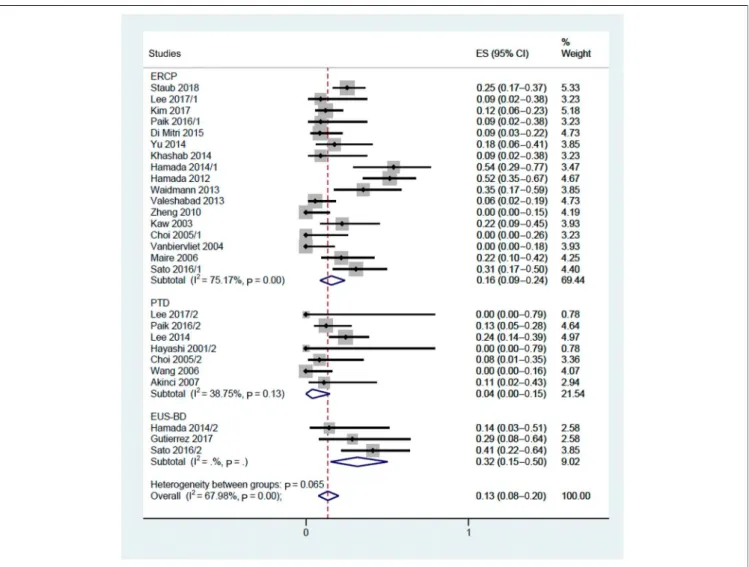Downloadedfromhttps://journals.lww.com/ctgbyBhDMf5ePHKav1zEoum1tQfN4a+kJLhEZgbsIHo4XMi0hCywCX1AWnYQp/IlQrHD3be73+7zLk/TbGIK5HivDXmFNDtrjO75HIdKLEBOZEQ5SzCfBYVmlHQ==on04/20/2020
Downloadedfrom https://journals.lww.com/ctgby BhDMf5ePHKav1zEoum1tQfN4a+kJLhEZgbsIHo4XMi0hCywCX1AWnYQp/IlQrHD3be73+7zLk/TbGIK5HivDXmFNDtrjO75HIdKLEBOZEQ5SzCfBYVmlHQ==on
04/20/2020
Double Stenting for Malignant Biliary and Duodenal Obstruction: A Systematic Review and Meta-Analysis
Anna F ´abi ´an, MD1, Ren ´ata Bor, MD1, No ´emi Gede, MSc2, P ´eter Bacsur1, D ´aniel P ´ecsi, MD2, P ´eter Hegyi, MD, PhD, DSc2,
Barbara T ´oth, MPharm, PhD3, Zsolt Szak ´acs, MD2, ´Aron Vincze, MD, PhD4, Istv ´an Ruzsics, MD5, Zolt ´an Rakonczay Jr, MD, PhD, DSc6, B ´alint Er}oss, MD2, R ´obert Sepp, MD, PhD, DSc7and Zolt ´an Szepes, MD, PhD1
INTRODUCTION: Data about the efficacy of palliative double stenting for malignant duodenal and biliary obstruction are limited.
METHODS: A systematic literature search was performed to assess the feasibility and optimal method of double stenting for malignant duodenobiliary obstruction compared with surgical double bypass in terms of technical and clinical success, adverse events, reinterventions, and survival. Event rates with 95%
confidence intervals were calculated.
RESULTS: Seventy-two retrospective and 8 prospective studies published until July 2018 were included.
Technical and clinical success rates of double stenting were 97% (95%–99%) and 92% (89%–95%), respectively. Clinical success of endoscopic biliary stenting was higher than that of surgery (97%
[94%–99%] vs 86% [78%–92%]). Double stenting was associated with less adverse events (13%
[8%–19%] vs 28% [19%–38%]) but more frequent need for reintervention (21% [16%–27%] vs 10%
[4%–19%]) than double bypass. No significant difference was found between technical and clinical success and reintervention rate of endoscopic retrograde cholangiopancreatography (ERCP), percutaneous transhepatic drainage, and endoscopic ultrasound-guided biliary drainage. ERCP was associated with the least adverse events (3% [1%–6%]), followed by percutaneous transhepatic drainage (10% [0%–37%]) and endoscopic ultrasound-guided biliary drainage (23% [15%–33%]).
DISCUSSION: Substantially high technical and clinical success can be achieved with double stenting. Based on the adverse event profile, ERCP can be recommended as the first choice for biliary stenting as part of double stenting, if feasible. Prospective comparative studies with well-defined outcomes and cohorts are needed.
SUPPLEMENTARY MATERIALaccompanies this paper athttp://links.lww.com/CTG/A243,http://links.lww.com/CTG/A244,http://links.lww.com/CTG/A245,http://
links.lww.com/CTG/A246,http://links.lww.com/CTG/A247,http://links.lww.com/CTG/A248,http://links.lww.com/CTG/A249,http://links.lww.com/CTG/A250,http://
links.lww.com/CTG/A251
Clinical and Translational Gastroenterology 2020;11:e00161. https://doi.org/10.14309/ctg.0000000000000161
INTRODUCTION
Unresectable pancreatobiliary, gastroduodenal, and metastatic malignancies can lead to concomitant biliary and duodenal ob- struction. Biliary obstruction may occur in 51%–72% of advanced pancreatobiliary cancers (1,2), and duodenal obstruction rate has also risen to 38% because of oncologic advances and consequently longer patient survival (3).
Historically applied double surgical bypass (gastroenterostomy with biliodigestive anastomosis) (4) is often associated with sub- stantial perioperative mortality and morbidity (2) because of poor
performance status and frequent comorbidities (5). Because duo- denal obstruction usually develops after biliary obstruction and it may occur in up to 20% of those who underwent single biliary bypass, creation of prophylactic gastroenteric anastomosis (GEA) was proposed in patients with unresectable disease confirmed at surgical exploration (2,6). Prophylactic GEA use reduces the chance for developing duodenal obstruction without impairing the short-term outcomes in pancreatic and periampullary cancer (6,7).
Therefore, most studies reporting double bypass involve cases where biliary bypass was combined with prophylactic GEA (8–10).
1First Department of Medicine, University of Szeged, Szeged, Hungary;2Institute for Translational Medicine, Medical School, University of P ´ecs, P ´ecs, Hungary;
3Department of Pharmacognosy, University of Szeged, Szeged, Hungary;4Division of Gastroenterology, First Department of Medicine, Medical School, University of P ´ecs, P ´ecs, Hungary;5First Department of Medicine, Department of Pulmonology, Medical School, University of P ´ecs, P ´ecs, Hungary;6Department of Pathophysiology, University of Szeged, Szeged, Hungary;7Second Department of Internal Medicine and Cardiology Center, University of Szeged, Szeged, Hungary.
Correspondence:Zolt ´an Szepes, MD, PhD. E-mail: szepes.zoltan@med.u-szeged.hu.
Received December 3, 2019; accepted February 26, 2020; published online April 13, 2020
© 2020 The Author(s). Published by Wolters Kluwer Health, Inc. on behalf of The American College of Gastroenterology
American College of Gastroenterology Clinical and Translational Gastroenterology
REVIEW ARTICLE 1
Endoscopic placement of plastic or self-expandable metal stents has offered a minimal invasive palliation alternative for patients unsuitable for surgery. Currently, transpapillary stentingviaen- doscopic retrograde cholangiopancreatography (ERCP) is the standard treatment of malignant biliary obstruction alone (11,12).
In the case of ERCP failure (reported in approximately 10% because of altered anatomy or duodenal obstruction), biliary stenting can be performed via percutaneous transhepatic drainage (PTD) or en- doscopic ultrasound-guided biliary drainage (EUS-BD) (13). Re- cently, thefirst-line use of EUS-BD in malignant biliary obstruction was also proposed based on comparable technical and clinical success and favorable adverse event and reintervention rates over ERCP (14). In 2018, a Cochrane Database Systematic Review comparing stent placement and surgical palliation for malignant gastric outlet obstruction found quicker resumption of oral intake and reduced hospital stay as benefits and higher reintervention rate as a drawback of duodenal stenting over surgery (15).
Combined biliary and duodenal stent placement (double stenting) wasfirst reported in 1994 (16). Adequate modality for double stenting should be chosen based on duodenal obstruction type (located above [type I], at the level [type II], or below the ampulla [type III]) and sequence of biliary and duodenal stenting (biliaryfirst, duodenalfirst, or simultaneous). Although techni- cally challenging, biliary stenting can also be performed through the mesh of a duodenal stent (11). Nevertheless, the efficacy data of double stenting are limited, as usually there are few such cases in a single center (17), partly because of the sequential de- velopment of biliary and duodenal obstruction, and its place in the therapeutic algorithm is not clearly specified.
AIMS
This systematic review and meta-analysis aimed to assess efficiency and safety of double stenting in malignant duodenobiliary ob- struction compared with surgical double bypass in terms of technical and clinical success, survival, adverse events, and reintervention rate and determine the optimal method for double stenting: duodenal stenting combined with ERCP vs PTD vs EUS-BD.
METHODS
Protocol and registration
This work was reported according to the Preferred Reporting Items for Systematic Reviews and Meta-Analyses 2009 Statement (18). The study protocol was registered at the International Prospective Register of Systematic Reviews (PROSPERO) with the registration number CRD42018103101.
Eligibility criteria
We included studies reporting the following outcome measures in patients with concomitant malignant biliary and duodenal ob- struction treated either with combined duodenal and biliary stenting (via ERCP, PTD, or EUS-BD) or with double surgical bypass (gastroenterostomy with biliodigestive anastomosis): tech- nical and clinical success, survival, adverse events, and reinter- vention rates. Studies reporting about temporary stenting were excluded. Studies reporting about prophylactic GEA were in- cluded; however, technical and clinical success could only be interpreted as that of biliary bypass in such cases.
Both experimental and observational studies (either pro- spective or retrospective) without respect to their primary objectives were included. Conference abstracts were included to minimize publication bias. Case reports and case series reporting
about less than 5 patients were excluded from quantitative analysis. Eligible articles were written in English or had an English abstract (data were obtained from the abstract in such cases).
Information sources and search strategy
A systematic literature search limited to human studies without languagefilters was performed by 2 reviewers in the PubMed (MEDLINE), EMBASE, Web of Science, and Cochrane Central Register of Controlled Trials (CENTRAL) databases with the terms “([biliary obstruction AND duodenal obstruction] OR bilio-duodenal obstruction) AND (stent OR surgery).”Thefinal search was performed on July 17, 2018. Reference lists of included articles were also investigated to capture all relevant studies.
Study selection and data collection process
After the removal of duplicates, the following data were extracted by 2 independent authors: age, gender, type of underlying ma- lignancy, type of duodenal obstruction, method of biliary drain- age, type of biliary and duodenal stents, timing of stent placement, technical and clinical success, adverse events, reintervention rate, survival, and follow-up.
Risk of bias assessment
Risk of bias was assessed using a modified version of the Newcastle–Ottawa Scale (NOS) by 2 independent review authors.
Disagreements were resolved by discussion, with involvement of a third review author, when needed.
The modified NOS contained 7 items covering 2 main domains (selection and outcome) as comparability domain was not applicable because of the lack of head-to-head comparative studies: representativeness of the exposed cohort, selection of the nonexposed cohort, ascertainment of exposure, demonstration that the outcome of interest was not present at the study’s start (selection domain), assessment of outcome, and length and ad- equacy of follow-up (outcome domain). Studies could be awarded a maximum of one star for each item. Each item was rated as“high risk”(zero stars) or“low risk”(one star).
Data synthesis and statistical methods
Pooled event rate was calculated for events, and pooled mean was calculated for continuous data with 95% confidence intervals (CIs).
A random-effect model was applied in all analyses with the DerSimonian–Laird estimation. Statistical heterogeneity was ana- lyzed using the I2andx2tests to gain probability values;P,0.10 was defined to indicate significant heterogeneity. The I2test rep- resents the percentage of total variability across studies because of heterogeneity. I2values of 30%–60%, 50%–90%, and 75%–100%
corresponded to moderate, substantial, and considerable hetero- geneity, respectively, based on Cochrane’s handbook (19). Statis- tical analyses were performed with Comprehensive Meta-Analysis Software and STATA. Forest plots displayed the results of the meta-analysis.
Outcome measures
Overall technical success was defined as adequate placement of both biliary and duodenal stents or successful performance of double bypass in the case of manifest gastric outlet and biliary obstruction (4,20,21). Clinical success of biliary stenting was usu- ally defined as a postprocedural reduction in serum bilirubin level within 2 weeks. However, this definition varied remarkably across studies: One study required normalization of serum bilirubin level
Clinical and Translational Gastroenterology VOLUME 11 | APRIL 2020 www.clintranslgastro.com
REVIEW ARTICLE
F´abi´an et al.
2
(22), whereas others considered clinical success when a 25% or 50%
reduction in bilirubin was observed (17,21,23) or only stated im- provement of biliary obstruction symptoms without further clari- fication (4,24). Clinical success of duodenal stenting, when clarified other than clinical improvement of symptoms (4,24), mainly re- ferred to a better score on the gastric outlet obstruction scoring system (21,23). Technical and clinical success was determined for that of biliary stenting/bypass and duodenal stenting/bypass to- gether and separately as well.
Cases of prophylactic GEA were also included in the meta- analysis because it is recommended and commonly applied in the surgical treatment of pancreatic tumors. However, when pro- phylactic GEA was included in the surgical group, technical and clinical success could only be interpreted as that of biliary bypass, and accordingly, this was compared with technical and clinical success of biliary stenting.
Survival was determined as the time to death from both stents’
placement (or creation of double bypass). For sequential biliary and duodenal stenting, survival was calculated from placement of the later stent. The following adverse events were investigated: pan- creatitis, cholangitis, cholecystitis, bleeding, bile leakage, perfora- tion, pneumoperitoneum, abdominal pain, wound infection, pneumonia, and others (including symptomless amylasemia, atrial fibrillation, cardiac arrest, aspiration, intra-abdominal abscess, and deep vein thrombosis). Stent migration, recurrent biliary
obstruction (RBO; defined mostly as per the Tokyo criteria (25)), and recurrent duodenal obstruction (RDO; reoccurrence of gastric outlet obstruction symptoms) were also investigated. Adverse event rate was given as the number of patients with one or more adverse events. Reintervention rate was defined as the number of patients who required endoscopic or surgical intervention to treat RBO or RDO.
RESULTS
Study selection and characteristics
A total of 2,765 records were identified through a database search:
833 in PubMed, 1,531 in EMBASE, 382 in Web of Science, and 19 in CENTRAL. Nine additional records were found from the reference list of relevant articles. After removing duplicates and irrelevant records, 121 studies were found eligible. From these, 41 case reports and case series were excluded from quantitative synthesis (Figure 1).
Therefore, 80 studies were included in the pooled analysis: 8 pro- spective and 72 retrospective observational studies (Tables 1 and 2).
No randomized controlled trials were available. Fifty-five studies including 5,026 patients reported about double stenting, 22 with 1,080 patients about double bypass, and only 3 about both the techniques (including 64 patients who underwent double stenting and 93 with double bypass) (8,22,26). However, insufficient out- come reporting hindered the direct comparison of outcomes.
Figure 1.The Preferred Reporting Items for Systematic Reviews and Meta-Analyses flowchart.
American College of Gastroenterology Clinical and Translational Gastroenterology
REVIEW ARTICLE
Malignant Biliary and Duodenal Obstruction 3
Table1.Characteristicsofincludedstudiesdealingwithendoscopicdoublestenting Endoscopic StudyDesign No. Centers No. patients Age(yr) Sex(female %oftotal) Duodenum obstruction Typeof malignancy BiliarystentingTypeof biliary stent Typeof duodenum stent TimingFollow-up(d) MeanMedianSDRange
Type I
Type II Type IIIERCP EUS- BDPTD Biliary firstSimultaneous Duodenal firstMeanMedianSDIQRRange Kawetal.(30)Retrospective11865——46–8539NAPancreatic,bileduct,metastatic, other
1800SEMSNANANA Vanbiervlietetal. (31)
Retrospective11872——60–8339NAPancreatic1800SEMSNA0018NA Choietal.(32) (abstract) Retrospective123NANANAPancreatic,ampullary,gastric,bile duct,gallbladder 11012NANA1706NA Olsenetal.(33) (abstract)
Retrospective129NANANAPancreatic,gastric,bileduct,other2900SEMSNA272NA Maireetal.(34)Retrospective123—65—32–85NANAPancreatic2300PS,SEMSNA1661NA Suliemanetal. (35)(abstract) RetrospectiveNA14NANANAPancreatic,gallbladder,metastatic1400SEMSNA743NA Wangetal.(36) (abstract)
Retrospective12062———15NANA0020NANA1640NA Akincietal.(37)Retrospective1961——42–8033NAPancreatic,duodenal,bileduct009SEMSNA540NA Houetal.(38) (abstract) Retrospective112NANANANA0012SEMSNANANA Mutignanietal. (39)
Prospective16468.5—12.9—4731258Pancreatic,gastric,metastatic,other6202PS,SEMSuSEMS46144NA Moonetal.(40)Prospective1872.8——51–8538350Pancreatic,ampullary,gastric,bile duct,metastatic 800SEMSuSEMS260NA Katsinelosetal. (41)
Retrospective432—77—52–8934NAPancreaticNASEMSNA2570NA Keranenetal.(42)Retrospective157—72—40–8959NAPancreatic,duodenal,gastric,bile duct,other 5205PS,SEMSNA46110—62——1–933 Iwamuroetal.(43)Retrospective1773——58–8629NAPancreatic,ampullary070PScSEMS02589———37–186 Zhengetal.(44) (abstract)
Retrospective122NANANANA2200NANANA180———— Lietal.(45) (abstract) Retrospective118NANANAPancreatic,duodenal,bileduct, metastatic NASEMSNA1440NA Priceetal.(46) (abstract)
Prospective142NANANAPancreatic,gastric,bileduct, gallbladder 3309PS,SEMSNA4002NA Ardenghetal.(47) (abstract)
Retrospective1222259—26–87NANAPancreaticNANANA0220NA Hamadaetal.(48)Retrospective53369——62–77402355Pancreatic,bileduct,other3300SEMScSEMS20112NA Kannoetal.(49) (abstract) Retrospective12172———62NANA1362NANA1290NA Khashabetal. (50)
Retrospective2971.1———44270Pancreatic,duodenal,other090SEMSNA036NA Kimetal.(51)Retrospective12471—11.643–89504137Pancreatic,gastric,bileduct13011PS,SEMSNA2301NA
Clinical and Translational Gastroenterology VOLUME 11 | APRIL 2020 www.clintranslgastro.com
REVIEW ARTICLE
F´abi´an et al.
4
Table1.(continued) Endoscopic StudyDesign No. Centers No. patients Age(yr) Sex(female %oftotal) Duodenum obstruction Typeof malignancy BiliarystentingTypeof biliary stent Typeof duodenum stent TimingFollow-up(d) MeanMedianSDRange
Type I
Type II Type IIIERCP EUS- BDPTD Biliary firstSimultaneous Duodenal firstMeanMedianSDIQRRange Maluf-Filhoetal. (52)
Retrospective157072746–8860NAPancreatic,other050SEMSuSEMS05037.21716.3—4–90 Kushniretal.(53) (abstract) Retrospective16265—11.6—45NAPancreatic,metastatic62015aNANANANA Panetal.(54) (abstract)
Retrospective110NANA631Pancreatic,ampullary,bileduct, gallbladder 640NANA316NA Tonozukaetal. (55)
Retrospective11168.5—8.1—271100Pancreatic380SEMSNA641NA Valeshabadetal. (26)(abstract) Retrospective63565.9———49NA18NANA3512a9aPS,SEMSNA003578.4———1–500 Waidmannetal. (56)
Retrospective11770—1150–8547NAPancreatic,gastric,bileduct, gallbladder,metastatic,other 1700PS,SEMScSEMS, uSEMS NA57—71—1–275 Carvalhoetal.(57) (abstract)
Retrospective350NANA35224NA4208NANANANA Canenaetal.(23)Retrospective45071.270—46–904235114Pancreatic,duodenal,ampullary, gastric,bileduct,gallbladder,other 4208SEMSuSEMS29156NA Hamadaet–al. (58)
Retrospective32066.6651.158–7645956Pancreatic,ampullary,gastric137PS,SEMScSEMS, uSEMS
0020NA Khashabetal. (59)
Retrospective63564.6—13.5—456192Pancreatic,duodenal,metastatic, other 11b13a9aPS,SEMSuSEMS0035NA Leeetal.(60)Retrospective14561.3—11.638–834721195Pancreatic,duodenal,gastric,bile duct,gallbladder,other
0045SEMScSEMS, uSEMS 14031—132——8–920 Yuetal.(61)Retrospective11776.6—6.562–8718781Pancreatic, duodenal, bileduct
1700NANA1700NA DiMitrietal. (62)(abstract)
Retrospective13572.4—10.1—37NAPancreatic,duodenal,bileduct, other 3500NANA0035NA Kuboetal.(63) (abstract)
Retrospective14475.4———48NANA34010NANA33110NA Mantaetal.(64)Retrospective11565.6——38–8020NAPancreatic3120SEMSuSEMS1203NA Matsumotoetal. (65)(abstract) Retrospective147NANANAPancreatic32150NANANANA Sanchez-Ocana etal.(66) (abstract)
Retrospective16177——30–926926341Pancreatic,gastric,other37240NANA25927NA Sanoetal.(67) (abstract) Retrospective121NANA1362PancreaticNANANA1740NA Williamsonetal. (8)
Retrospective27—70—42–8138NAPancreatic,duodenal,ampullary, bileduct,other NAPS,SEMSNA700NA Fuetal.(22)Retrospective12264.7—9.3—30NAPancreatic0022NANANANA
American College of Gastroenterology Clinical and Translational Gastroenterology
REVIEW ARTICLE
Malignant Biliary and Duodenal Obstruction 5
Table 1. (continued)
Endoscopic
Study Design
No.
Centers No.
patients
Age (yr)
Sex (female
% of total)
Duodenum obstruction
Type of malignancy
Biliary stenting Type of
biliary stent
Type of duodenum
stent
Timing Follow-up (d)
Mean Median SD Range
Type I
Type II
Type
III ERCP
EUS-
BD PTD
Biliary
first Simultaneous
Duodenal
first Mean Median SD IQR Range
Ogura et al. (68) Retrospective 1 39 70.3 — 9 — 46 28 11 Pancreatobiliary, other 0 39 0 SEMS uSEMS 0 0 39 NA
Paik et al. (69) (abstract)
Retrospective 1 43 NA NA NA Pancreatic, duodenal, bile duct,
gallbladder, metastatic, other
11 0 32 NA NA 0 0 43 NA
Sato et al. (24) Retrospective 1 43 65.4 — 9.8 — 49 12 18 13 Pancreatic, duodenal, gastric, bile
duct
26 17 0 SEMS uSEMS NA 90 — — — —
Yao et al. (70) (abstract)
Retrospective 1 42 NA NA NA NA 42 0 0 NA NA 0 0 42 NA
Zhao et al. (71) Retrospective 1 20 63.1 — 8.2 35–72 35 NA Pancreatic, duodenal, bile duct,
metastatic
0 0 20 NA NA 16 1 3 NA
Bulut et al. (72) (abstract)
Retrospective 1 21 58.7 — 15 — 38 NA Pancreatic, duodenal, ampullary,
gastric, bile duct, metastatic, other
0 0 21 NA uSEMS 14 7 0 112.6 — 152 — —
Fukushima et al.
(73) (abstract)
Retrospective 1 15 NA NA 7 5 3 NA NA NA NA NA NA
Brewer Gutierrez et al. (74)
Retrospective 3 7 64.7 — 12.5 — 57 NA Pancreatic 0 7 0 SEMS LAMS 0 7 0 — 106 — 66–235 —
Kim et al. (75) Retrospective 1 58 61.1 — 12 — 38 NA Pancreatic, duodenal, gastric, bile
duct, gallbladder, metastatic
58 0 0 SEMS cSEMS 58 0 0 NA
Lee et al. (76) Retrospective 1 12 67.5 — — 38–82 50 4 3 5 Pancreatic, ampullary, bile duct,
gallbladder
11 0 1 SEMS uSEMS 6 6 NA
Matsumoto et al.
(21)
Retrospective 1 81 — 66 — 41–91 40 38 32 11 Pancreatic, ampullary, gastric, bile
duct, gallbladder, metastatic
62 19 0 PS, SEMS cSEMS,
uSEMS
50 31 0 NA
Hamada et al. (17) Retrospective 16 110 68.8 — 11.5 — 52 45 46 19 Pancreatic, ampullary, gastric, bile
duct, gallbladder, other
90 20 0 PS, SEMS NA 67 29 14 NA
Hori et al. (4) Retrospective 8 109 — 70 — 39–96 44 23 74 12 Pancreatobiliary, gastric, other 101 0 8 SEMS cSEMS,
uSEMS
88 12 9 NA
Rai et al. (77) (abstract)
Prospective 1 12 NA 67 NA NA 7 5 0 SEMS NA NA NA
Staub et al. (20) Retrospective 2 71 66.87 — — 31–92 38 46 21 4 Pancreatic, duodenal, ampullary,
other
71 0 0 PS, SEMS NA 71 NA
Yamao et al. (78) Retrospective 5 39 68.5 — 11.3 — 41 11 16 12 Pancreatic 25 14 0 PS, SEMS NA 9 30 NA
cSEMS, covered self-expandable metallic stent; ERCP, endoscopic retrograde cholangiopancreatography; EUS-BD, endoscopic ultrasound-guided biliary drainage; IQR, interquartile range; LAMS, lumen-apposing metallic stent;
NA, not available; PS, plastic stent; PTD, percutaneous transhepatic drainage; SEMS, self-expandable metallic stent; uSEMS, uncovered self-expandable metallic stent.
aEUS-BD and/or PTD was performed in case of ERCP failure.
bThirteen patients underwent successful biliary cannulation with ERCP, but stent was inserted only in 11 patients.
ClinicalandTranslationalGastroenterologyVOLUME11|APRIL2020www.clintranslgastro.com
REVIEW ARTICLE
F´abi´anetal.6
Table 2. Characteristics of included studies dealing with surgical double bypass
Surgical
Study Design
No.
Centers No.
patients
Age Sex (female % of
total) Type of malignancy
Prophylactic GEA
Follow-up (d)
Mean Median SD IQR Range Mean Median SD Range
Levi et al. (79) Retrospective 1 18 NA NA Pancreatic NA NA
Wongsuwanporn and Basse (80) (abstract)
Retrospective 1 26 NA NA Pancreatic NA NA
Lee (81) Retrospective 1 65 NA NA Pancreatic, ampullary NA NA
Parker and Postlethwaite (82) Retrospective 1 13 59 — 11 — — 0.5 Pancreatic NA NA
La Ferla and Murray (83) Retrospective 1 14 65 — — — 45–92 36 Pancreatic 14 NA
Singh et al. (84) Retrospective 1 70 63 — — — 12–88 46 Pancreatic 20 NA
Casaccia et al. (85) Prospective 1 2 — 64 — — 53–72 33 Pancreatic 0 12.5 — — 7–18
Hamade et al. (86) Retrospective 1 8 — 70 — — 26–81 43 Pancreatic, duodenal, bile duct 5 NA
Hao et al. (87) Retrospective 1 22 63 — — — 52–76 NA Pancreatic, ampullary, bile duct, duodenal 22 NA
Khan et al. (88) Retrospective 1 2 77 — — — 63–90 53 Pancreatic, duodenal, gastric, bile duct 0 NA
Mortenson et al. (89) Retrospective 1 38 61 — 11 — — NA NA NA NA
Tang et al. (90) (abstract) Retrospective 1 35 — 69 — — — 62 NA NA NA
Ghanem et al. (91) Prospective 1 8 — 67 — — 26–81 59 Pancreatic 3 NA
Lesurtel et al. (27) Retrospective 1 83 64 — 11 — — 46 Pancreatic 72 270 — 270 —
Mann et al. (92) Retrospective 1 102 — 65 — — 36–86 39 Pancreatic, duodenal, ampullary, bile duct,
metastatic
92 NA
Ausania et al. (93) Prospective 1 50 — 64 — — 39–79 34 Pancreatic, duodenal, ampullary, bile duct,
other
50 — 300 — 120–990
Lyons et al. (10) Retrospective 1 60 65 — — — — 45 Pancreatic 50 NA
Malde et al. (94) (abstract) Retrospective 1 48 — — — — — 40 Pancreatic NA NA
Valeshabad et al. (26) (abstract) Retrospective 6 3a 65.9 — — — — 49 NA 0 NA
Bartlett et al. (5) Retrospective 315 351 66 — — 59–75 — 45 Pancreatic NA NA
Kohan et al. (9) Prospective 1 42 64 — — — 38–88 56 Pancreatic 28 NA
Kofokotsios et al. (95) Retrospective 1 11 — 70 — — 48–77 36 Pancreatic 11 NA
Williamson et al. (8) Retrospective 2 59 — 66 — — 39–81 NA Pancreatic, duodenal, ampullary, bile duct,
other
59 NA
Fu et al. (22) Retrospective 1 31 61 — 9.4 — — NA Pancreatic 31 NA
Giuliani and Bonetti (96) (abstract) Retrospective 1 12 — 67 — — 41–83 42 Pancreatic 0 — 323 — 30–3,296
GEA, gastroenteric anastomosis; IQR, interquartile range; NA, not available.
aSurgery was performed in case of ERCP failure.
AmericanCollegeofGastroenterologyClinicalandTranslationalGastroenterology
REVIEW ARTICLE
MalignantBiliaryandDuodenalObstruction7
Underlying malignancy was specified in 73% of cases: pan- creatobiliary cancer in 4,149, gastroduodenal cancer in 212, metastatic cancer in 49, and other malignancies in 144 cases.
Duodenal stenosis was located above and at the ampullary level in 43.7% each and below the ampulla in 12.5% of reported cases.
Seventeen studies reported about prophylactic GEA, and it was applied in 69% of surgical cases. In case of double stenting, biliary stenting was performed via ERCP in 69%, PTD in 17%, and EUS-BD in 14% of patients. Biliary and duodenal stents were placed simultaneously in 25.5% of reported cases; biliary stenting preceded duodenal in 45.7% and followed it in 28.8%.
The mean interval between stent placements was 1146106 days (2016173 days for biliaryfirst and 74675 days for duodenal first).
Inpost hocanalysis, the mean age of patients who underwent double stenting was significantly higher (67.9 years [95% CI:
67.0–68.9 years; I2588.0%]) than that of those who underwent double bypass (63.7 years [95% CI: 62.3–65.0 years; I2 5 89.2%]). Gender distribution showed no difference between the groups.
Risk of bias assessment
Risk of bias of individual studies was assessed with the NOS (see Table, Supplementary Digital Content 1, http://links.lww.com/
CTG/A243). Baseline characteristics were reported in almost all journal articles but were only partially available in conference abstracts (Tables 1 and 2). Clinical success rate’s definition varied, and other outcome measures were defined mostly uniformly (4,17,21–24). Although assessment of different outcomes was reported reliably in more than 90% (Figure 2), outcomes were reported heterogeneously (see Tables, Supplementary Digital Content 2 and 3, http://links.lww.com/CTG/A244 and http://links.
lww.com/CTG/A245). Adequate follow-up data were available in only approximately 40%, but the length of follow-up was appro- priate for assessment of outcomes, when reported (Figure 2).
Meta-analytical calculations
Technical and clinical success. Overall technical and clinical success rates of double stenting were 97% (95% CI: 95%–99%) and 92% (95% CI: 89%–95%), respectively. Subgroup analysis of different biliary stenting modalities found no difference in
Figure 2.Risk of bias assessment of individual studies according to the modified Newcastle–Ottawa Scale. (a) Endoscopic studies and (b) surgical studies. Each item was rated as“high risk”(zero stars) or“low risk”(one star). Selection domain: (i) representativeness of the exposed cohort, (ii) selection of the nonexposed cohort, (iii) ascertainment of exposure, and (iv) demonstration that the outcome of interest was not present at the start of study. Outcome domain: (v) assessment of outcome, (vi) length of follow-up, and (vii) adequacy of follow-up.
Clinical and Translational Gastroenterology VOLUME 11 | APRIL 2020 www.clintranslgastro.com
REVIEW ARTICLE
F´abi´an et al.
8
technical and clinical success (see Figures, Supplementary Digital Content 4 and 5, http://links.lww.com/CTG/A246 and http://
links.lww.com/CTG/A247).
Considering frequent prophylactic GEA use during surgical double bypass, technical and clinical success in this group could only be assessed for biliary bypass. No difference was found be- tween technical success of endoscopic stenting and surgical biliary bypass (see Figure, Supplementary Digital Content 6, http://links.
lww.com/CTG/A248), whereas clinical success of endoscopic bil- iary stenting was higher (97% [95% CI: 94%–99%; I2567.3%] vs 86% [95% CI: 78%–92%; I2 519.9%], respectively) (Figure 3).
Technical and clinical success of duodenal stenting was 99% (95%
CI: 97%–100%) and 97% (95% CI: 94%–99%), respectively.
Adverse event rate.Double stenting was associated with less ad- verse events compared with surgical double bypass (13% [95% CI:
8%–19%; I2586.3%] vs 28% [95% CI: 19%–38%; I2589.3%]) (Figure 4). See Table (Supplementary Digital Content 7, http://
links.lww.com/CTG/A249) for details of adverse events associated with double stenting and double bypass. Adverse events occurred at 67.8 days on average (95% CI: 5.1–128.4 days) postprocedure.
There was no difference between adverse events’occurrence time after double stenting and double bypass (52.8 days [95% CI:
23.7–129.3 days] vs 108.7 days [95% CI: 123.2–340.6 days], respectively).
ERCP was associated with the least adverse events (3% [95% CI:
1%–6%; I2542.8%]), followed by PTD (10% [95% CI: 0%–37%;
Figure 3.Clinical success of biliary bypass in case of double stenting and double surgical bypass (including cases with prophylactic GEA). CI, confidence interval; ES, effect size; GEA, gastroenteric anastomosis.
American College of Gastroenterology Clinical and Translational Gastroenterology
REVIEW ARTICLE
Malignant Biliary and Duodenal Obstruction 9
Figure 4.Adverse events related to double stenting and double surgical bypass. CI, confidence interval; ES, effect size.
Clinical and Translational Gastroenterology VOLUME 11 | APRIL 2020 www.clintranslgastro.com
REVIEW ARTICLE
F´abi´an et al.
10
I2590.2%]) and EUS-BD (23% [95% CI: 15%–33%; I251.8%]) (Figure 5). The difference was significant between ERCP and EUS-BD.
Reintervention rate. More reinterventions were needed after double stenting than after double bypass (21% [95% CI:
16%–27%; I2579.4%] vs 10% [95% CI: 4%–19%; I2590.2%]) (see Figure, Supplementary Digital Content 8, http://links.lww.
com/CTG/A250). In subgroup analysis, reinterventions were least likely to be necessary after PTD (4% [95% CI: 0%–15%]), followed by ERCP and EUS-BD (16% [95% CI: 9%–24%] and 32% [95% CI: 15%–50%], respectively) (Figure 6).
Although only 2 surgical studies specified whether reinterven- tion was necessary because of RBO or RDO (26,27), several en- doscopic studies investigated RBO and RDO separately (see Table, Supplementary Digital Content 2, http://links.lww.com/CTG/
A244). RBO was reported in a total of 285 cases, whereas RDO was reported in 100 cases. The mean time until the occurrence of RBO
and RDO was 167.3 days (95% CI: 93.0–241.6 days; I2596.0%) and 106.0 days (95% CI: 56.7–155.3 days; I2551.1%), respectively.
Survival. Cumulative mean survival of patients after double stenting was 156.4 days (95% CI: 128.3–184.5 days). Subgroup analysis of the different biliary stenting methods as part of double stenting revealed no difference in mean survival (see Figure, Supplementary Digital Content 9, http://links.lww.com/CTG/
A251). A small number of surgical studies and frequent GEA use in the surgical cohort prevented comparison of survival in the endoscopic and surgical cohorts.
DISCUSSION
Although double stenting for combined malignant biliary and du- odenal obstruction has been a treatment option for 25 years (16), its place in the therapeutic algorithm has not been clearly specified, and reliable efficacy data are still lacking because of the rare concomitant occurrence of these conditions (17). To the best of our knowledge,
Figure 5.Adverse events related to ERCP, EUS-BD, and PTD. CI, confidence interval; ERCP, endoscopic retrograde cholangiopancreatography; ES, effect size; EUS-BD, endoscopic ultrasound-guided biliary drainage; PTD, percutaneous transhepatic drainage.
American College of Gastroenterology Clinical and Translational Gastroenterology
REVIEW ARTICLE
Malignant Biliary and Duodenal Obstruction 11
this is thefirst systematic review and meta-analysis dealing with the feasibility of double endoscopic stenting in this scenario.
According to our findings, high cumulative technical and clinical success rates can be achieved with double stenting in this difficult-to-treat population. Success rates were comparable with traditionally applied surgical bypass regarding biliary bypass;
moreover, clinical success rate of endoscopic biliary bypass was even higher than that of surgery. The importance of thisfinding lies in the fact that those underwent double stenting were sig- nificantly older compared with those with double bypass, sug- gesting a potential superiority of double stenting in the elderly.
The adverse event profile of double stenting was favorable over that of double bypass in terms of not only numbers but also severity (death was only reported in the surgical cohort). However, the occurrence of adverse events depends on the method of biliary stenting: ERCP was associated with significantly fewer adverse events than EUS-BD. A previous meta-analysis about EUS-BD reported a similarly high cumulative adverse event rate (23.32%) (28). The high proportion of ERCPs in the double stenting cohort may also contribute to the overall adverse event rate.
However, double stenting was associated with higher reinter- vention rate independently of the biliary stenting method.
Duodenal stent placement alone was found to require more rein- terventions than surgery (15), and a recent multicenter randomized controlled trial comparing ERCP and EUS-BD as the primary treatment modality of malignant biliary obstruction reported reintervention rates of 42.6% and 15.6%, respectively (14). These facts, and plastic biliary stents’use in numerous studies and in- clusion of early studies dealing with double stenting, might also contribute to high reintervention rates (29). Considering cumula- tive survival and mean time until RBO or RDO, generally one reintervention will be necessary for patients undergoing double stenting. Nevertheless, PTD and EUS-BD were mostly second-line treatments after ERCP failure, and the exact number of sessions required to stent placement (especially for PTD, when stenting is often performed in a second session after temporary external bil- iary drainage) was generally not reported; therefore, complete burden of interventions cannot be reliably assessed.
Common prophylactic GEA use in double bypass also needs to be considered. Because it is associated with a lower risk of de- velopment of duodenal stenosis (6,7), lower rates of reinterven- tions for RDO are expected in the surgical cohort, which consists mostly of cases with prophylactic GEA. Therefore, cumulative overall reintervention rates might also be lower; however, details
Figure 6.Reintervention rate related to ERCP, PTD, and EUS-BD. CI, confidence interval; ERCP, endoscopic retrograde cholangiopancreatography; ES, effect size; EUS-BD, endoscopic ultrasound-guided biliary drainage; PTD, percutaneous transhepatic drainage.
Clinical and Translational Gastroenterology VOLUME 11 | APRIL 2020 www.clintranslgastro.com
REVIEW ARTICLE
F´abi´an et al.
12
